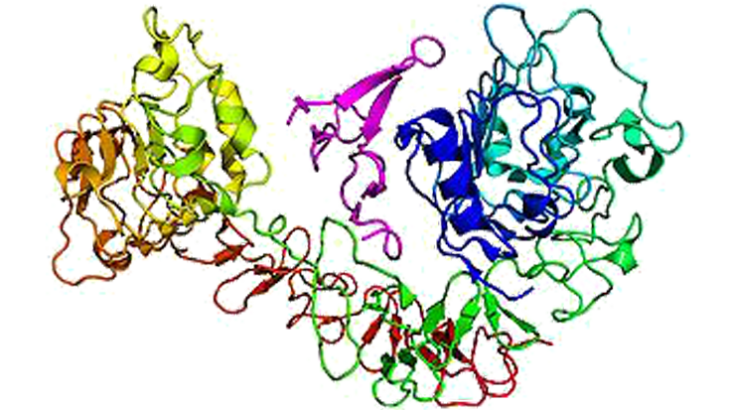Using HPC to improve cancer treatments

Professor Francesco Gervasio of UCL’s Department of Chemistry used the Emerald supercomputer to simulate the effect of gene mutations linked to the spread of cancer. His research could help develop more robust and effective cancer treatments.
Background
Epidermal Growth Factor Receptor (EGFR) is a protein that causes cell growth and differentiation. Gene mutations that lead to EGFR over-activity have been associated with a number of cancers, particularly lung cancer. Not surprisingly, EGFR is the target of a rapidly expanding class of anti-cancer drugs.
Recent efforts in treating cancer have focused on a part of the EGFR: the tyrosine kinase enzyme, which functions like an ‘off’ and ‘on’ switch for many cellular functions. Mutations of the EGFR kinase can cause it to become stuck in the ‘on’ or active position, causing tumour growth. Certain tyrosine kinase inhibitors (TKIs) have proven to be successful in slowing down tumour growth. Unfortunately, many cancer patients develop resistance to them.
“Although we also have a PRACE (Partnership for Advanced Computing in Europe) allocation of 24 million CPU hours, we can use this up very easily. Each simulation uses multiple replicas (at different temperatures) and so it has billions of sampling steps. The CPU time this takes is greatly reduced using Emerald’s GPU architecture because the code can be very highly parallelised, making it much more efficient”
Professor Francesco Gervasio, UCL Chemistry
Researchers need to understand more about common EGFR kinase mutations such as T790M and L858R, so as to develop more effective inhibitor drugs for cancer patients. Not much is known about these mutations, especially at an atomic level, but it is believed that changes to the transition between their active (‘on’) and inactive (‘off’) states are linked to their cancer-causing potential.
Because proteins are very flexible and can easily change conformation, simulating these transitions requires enormous computational effort. Recent research – using very complex molecular dynamics simulations (involving billions of steps) and conducted on multi-million dollar specialisedsupercomputer Anton – gave further evidence of how the kinase mutations affect the protein’s conformation. Even with this vast computational power, the researchers only observed two conformational changes, which were barely sufficient to grasp the full impact caused by the mutations.
What we did
Francesco’s work took advantage of recent progress in molecular dynamics and the availability of specialised computer hardware to try and understand more about EGFR kinase’s conformational changes, in particular the interaction between the mutations T790M and L858R. He chose to simulate this double mutant, along with both of the single mutants and a control mutant.
Francesco used an extremely efficient sampling technique called ‘parallel-tempered metadynamics’ to study the dynamics of the kinase very close to its equilibrium state. Here, he could observe a large number of small conformational transitions that occur in a very short timescale.
He used the GROMACS molecular dynamics software with the PLUMED metadynamics plug-in, adapted to run on the Emerald high performance computer system. Emerald uses specialised, highly parallelised GPU architecture (Graphical Processor Units, similar to the video cards used to accelerate the speed of the display on desktop PCs). Emerald was able to carry out the simulations much more quickly than would be possible on a machine with standard architecture (like Anton).
Francesco’s previous research group in Spain had purchased their own high performance system – consisting of rack-mounted servers with cheap PC graphics cards. It was expensive and difficult to keep running, due to the heat generated by the processors.
In contrast, Emerald has a specialised cooling system and dedicated staff to support and maintain it, with expert GPU developers to assist researchers with migrating their codes to the new architecture. Emerald is a shared SES facility, which further reduces the individual costs of this infrastructure.
“The system got so hot that at least one graphics card broke every month. People think computing power is now very cheap, but they don’t realise the true costs of a system like this”
Professor Francesco Gervasio, UCL Chemistry
Impact of the work
Francesco’s results have helped shed new light on how mutations of the EGFR kinase affect its likelihood of causing tumour growth. This new knowledge is important because it can be used to devise new strategies for developing tyrosine kinase inhibitors that are less susceptible to the development of drug resistance.
- Published article in Proceedings of the National Academy of Sciences of the United States of America (PNAS), Effects of oncogenic mutations on the conformational free-energy landscape of EGFR kinase
- The PLUMED plugin for free-energy calculations with molecular dynamics
- Professor Francesco Gervasio’s page at UCL Chemistry
- Science & Technology Facilities Council
- PRACE (Partnership for Advanced Computing in Europe)
- To find out about help available to researchers at UCL, visit our Help for UCL researchers page
Contact

Professor Francesco Gervasio
Chair of Biomolecular Modeling, UCL

